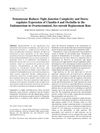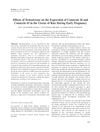April 2014 in “The FASEB Journal” Testosterone reduces knee movement, while flutamide and finasteride increase it.
23 citations
,
March 2014 in “International Journal of Molecular Sciences” Testosterone reduces knee flexibility by affecting relaxin receptors.
Knee laxity varies with menstrual cycle phases, being highest during ovulation and menstruation, and is influenced by sex-steroids.
 10 citations
,
December 2019 in “in Vivo”
10 citations
,
December 2019 in “in Vivo” Testosterone makes the connections in the uterus lining simpler and lowers certain protein levels, which might lead to infertility.
 5 citations
,
January 2020 in “in Vivo”
5 citations
,
January 2020 in “in Vivo” Testosterone changes important cell communication proteins in pregnant rats' uteruses, which might affect pregnancy success.

